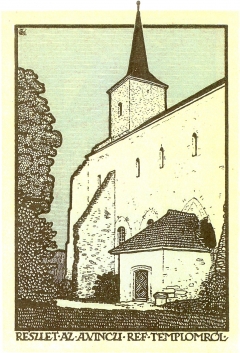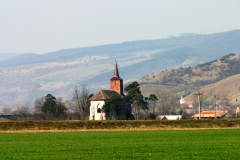

Vinţul de Jos (Alvinc) is set on the left side of Mures river, at 18 km from Alba Iulia. Is connected to Vurpar by a bridge. In 1205 is mentioned in the documents with the name of Wynch Inferior, in 1248 as Wynch, in 1289 Wynch Inferior, in 1290 Vinc, in 1342 Olwynch, in 1393 oppidum Alsowincz, in 1486 Alvinc, in 1510 Alwincz, in as 1552 Alvincz. Is inhabitants in the 12th century were Germans (hospites regni). The settlement’s first church was built in the 12th century in Romanian style. The community became reformed in about the 16th century. They were catholics before. In the Saint Katherine church (Szent Katalin), which got into the communities possession, after 1590 the side aisles were demolished, the arches were walled-up. Thus, the church was one long square with an octagonal shrine. The remains of the original vault can still be seen today. On the outer side of the shrine mural pictures can still be seen , and the Gothic stylish windows have also remained untouched. The 17th century stucco rosettes suggest that the church was used by reformed people. Later the vault was replaced by a wooden flat ceiling, which today is unpainted, and it was spoil by thieves. In spite of the historical storms the village has always been able to start over. (In 1870 a new school, teacher’s house was built, in two years they removed the traces of the flood from 1895, the church interior was remade, inaugurated, on the occasion of the Millennium seven linden trees were planted).In 1928 the wife of Károly Benedek, reverend and scrivener, bought a building for the school, where catholic and reformed children received elementary education. Since the flood from 1970, because of the forced departure of the congregation, the church stands empty. Only the shrine and a small part of the church can be seen from the 14th century basilica. In 2004 the church and the roof were repaired with the help of the Péter Bod Foundation from Alba Iulia and the Sándor Ágoston Foundation from Budapest, and some young volunteers. Its tabernacle and parish in July 2011 became the victim of a fire. The tower of the church was added in the 19th century. Now the community Now the community belongs to the Reformed Church from Alba Iulia. In 2011 it had 10 reformed members. According to the land rules from 1990 the Church recovers 13 ha of pasture, 7 h arable, 12 ha of forests. The reformed graveyard lies on a 2 ha land. Reverends: Péter Dengelegi, Péter Kapornai (-1640), Sámuel Enyedi (1670-1671), János Fáy/Fáji (1750-1757), Ferenc Szőcs (1757-1781), János Sövényfalvi (1781), István Koloswári (-1794), György Jakab (1806). After the World War II. from 15 January 1949 Árpád Péterffy Kibédi has been the reverend of this settlement for a long time. He was followed from 25 May 1984 Sándor Bálint. He was the last independent reformed reverend of Alvinc. He was followed for a short period by Sándor Jakab, after this Alvinc has fallen after the administration of Alba Iulia. After the World War II. Because of the flood from 1970 the reformed people were obliged to move from the church in the new location: in parish house. Since then the church is abandoned. Once it was surrounded by high walls which today are in ruins. After the War it was highly damaged because it was used as a warehouse and shelter for the sheep. Its administrator reverend: Imre Bárdi, András Gudor, Botond Gudor. Today belongs to the diaspora of the Reformed Church from Alba Iulia.




